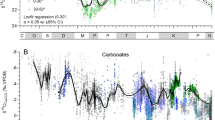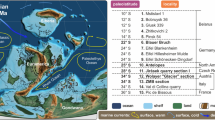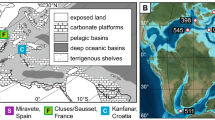Abstract
DURING the late Cainozoic, alternations between interglacial and glacial conditions, manifested by waning and waxing of continental ice sheets coincided with the rise and fall of seawater temperatures. Our palaeontological and oxygen isotope data indicate that although the major oceans and low latititude seas underwent large temperature variations, ∼ 5–10 °C, Arctic water temperatures remained near freezing point for at least the past 3 Myr, the time interval represented by the longest studied cores. We have determined palaeotemperatures from the ratio of left to right coiling Globigerina pachyderma1–3 and calculated palaeosalinities using the oxygen isotope palaeotemperature expression of Epstein et al.4.
This is a preview of subscription content, access via your institution
Access options
Subscribe to this journal
Receive 51 print issues and online access
$199.00 per year
only $3.90 per issue
Buy this article
- Purchase on Springer Link
- Instant access to full article PDF
Prices may be subject to local taxes which are calculated during checkout
Similar content being viewed by others
References
Ericson, D. B., Science, 130, 219 (1959).
Bandy, O. L., Palaeogeogr., Palaeoclimatol., Palaeoecol., 5, 63 (1968).
Herman, Y., in Marine Geology and Oceanography of the Arctic Seas (edit. by Herman, Y.), 283 (Springer, New York, 1974).
Epstein, S., Buchsbaum, R., Lowenstam, H., and Urey, H. C., Bull. geol. Soc. Am., 64, 1315 (1953).
Herman, Y., 169, 474 (1970).
Craig, H., and Gordon, L. I., in Symposium in Marine Geochemistry, 3, 277 (1965).
Treshnikov, A. F., Int. Oceanogr. Congr., N. Y., Abstr., 522 (1959).
Coachman, L. K., and Aagaard, K., in Marine Geology and Oceanography of the Arctic Seas (edit. by Herman, Y.), 1 (Springer, New York, 1974).
Van Donk, J., and Mathieu, G., J. geophys. Res., 74, 3396 (1969).
McCrea, J. M., J. chem. Phys., 18, 849 (1950).
Donahue, J. G., in Progress in Oceanography (edit. by Sears, M.), 4, 133 (Pergamon, New York, 1967).
Bandy, O. L., in Calibration of Hominoid Evolution (edit. by Bishop, W. W., and Miller, J. A.), 37 (Scottish Academic, New York, 1972).
Olsson, R. K., in Proc. second int. Planktonic Conf. (edit. by Farinacci, A.), 2, 921 (Edizioni Tecnoscienza, Rome, 1971).
Ruddiman, W. F., Bull. geol. Soc. Am., 82, 283 (1971)
Cox, A., Science, 163, 237 (1969).
Honkins, K., Bé, A. W. H., Opdyke, N. D., and Saito, T., in The Late Cenozoic Glacial Ages (edit. by Turekian, K. K.), 215 (Yale University Press, New Haven, 1971).
Author information
Authors and Affiliations
Rights and permissions
About this article
Cite this article
HERMAN, Y., O'NEIL, J. Arctic palaeosalinities during late Cainozoic time. Nature 258, 591–595 (1975). https://doi.org/10.1038/258591a0
Received:
Accepted:
Published:
Issue Date:
DOI: https://doi.org/10.1038/258591a0
This article is cited by
Comments
By submitting a comment you agree to abide by our Terms and Community Guidelines. If you find something abusive or that does not comply with our terms or guidelines please flag it as inappropriate.



